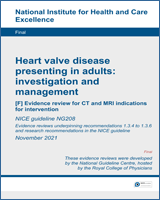From: Evidence review for CT and MRI indications for intervention

NCBI Bookshelf. A service of the National Library of Medicine, National Institutes of Health.
|
Risk factor and outcome (population) | Number of studies | Effect (95% CI) | Risk of bias | Imprecision | Indirectness | GRADE Quality |
|---|---|---|---|---|---|---|
|
LVEF <50% vs ≥50% on cardiac MRI for predicting all-cause mortality following aortic valve intervention – median follow-up 3.8 years (severe AS scheduled for AVR, 36% in NYHA class III/IV; mean age 69.67 years) | 1 (n=440) | Adjusted HR: 1.53 (0.76 to 3.06)a | Very seriousb | Seriousc | Seriousd | VERY LOW |
|
LVEF <50% vs ≥50% on cardiac MRI for predicting cardiovascular death, hospitalisation for cardiac causes, non-fatal stroke and symptomatic aggravation (worsening NYHA class) following AVR– median follow-up 38.8 months (severe AS scheduled for AVR, mean NYHA class 2.1; mean age 65.9 years) | 1 (n=43) | Unadjusted HR: 1.598 (0.567 to 4.505)e | Very seriousb | Seriousc | Very seriousf | VERY LOW |
|
LVEF 30–49% vs ≥50% on cardiac MRI for predicting all-cause mortality following TAVI – median follow-up 850 days for whole cohort, though unclear for those analysed here (those undergoing TAVI for AS, >70% with symptoms at rest or marked limitation of physical activity and median aortic valve area on echocardiography 0.60 cm2 in whole cohort, though unclear for those included in this analysis; median age for whole cohort was 81 years, not clear for those included in this analysis) | 1 (n=173) | Unadjusted HR: 1.19 (0.69 to 2.04)e | Very seriousb | Seriousc | Very seriousg | VERY LOW |
|
LVEF <30% vs ≥50% on cardiac MRI for predicting all-cause mortality following TAVI – median follow-up 850 days for whole cohort, though unclear for those analysed here (those undergoing TAVI for AS, >70% with symptoms at rest or marked limitation of physical activity and median aortic valve area on echocardiography 0.60 cm2 in whole cohort, though unclear for those included in this analysis; median age for whole cohort was 81 years, not clear for those included in this analysis) | 1 (n=122) | Unadjusted HR: 2.54 (1.17 to 5.53)e | Very seriousb | None | Very seriousg | VERY LOW |
Methods: multivariable analysis, adjusted for extracellular volume percentage, age, gender, LGE on cardiac MRI and peak aortic jet velocity (age prespecified in protocol was adjusted for)
Downgraded by 1 increment if the majority of the evidence was at high risk of bias, and downgraded by 2 increments if the majority of the evidence was at very high risk of bias
95% CI crosses null line
Population - all already have an indication for intervention as scheduled for aortic valve intervention
Methods: no multivariable analysis, unadjusted HR reported in the paper
Population - all already scheduled for AVR so no uncertainty as to whether there is an indication for intervention prior to cardiac MRI; and outcome - composite of multiple outcomes in the protocol combined rather than reported separately
Population - all already have an indication for intervention as scheduled for TAVI; and prognostic factor - splits LVEF into two separate thresholds compared with the same referent rather than using a single threshold. Also some uncertainty as to whether measured on cardiac MRI or echocardiography, though overall details suggest this is cardiac MRI measurements
From: Evidence review for CT and MRI indications for intervention

NCBI Bookshelf. A service of the National Library of Medicine, National Institutes of Health.